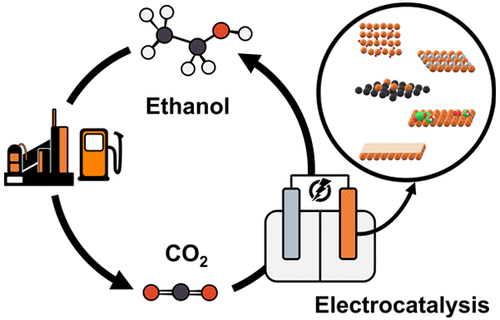当前位置:
X-MOL 学术
›
ACS Energy Lett.
›
论文详情
Our official English website, www.x-mol.net, welcomes your
feedback! (Note: you will need to create a separate account there.)
Electrochemical CO2 Reduction to Ethanol with Copper-Based Catalysts
ACS Energy Letters ( IF 19.3 ) Pub Date : 2021-01-27 , DOI: 10.1021/acsenergylett.0c02610 Dilan Karapinar 1 , Charles E. Creissen 1 , José Guillermo Rivera de la Cruz 1 , Moritz W. Schreiber 2 , Marc Fontecave 1
ACS Energy Letters ( IF 19.3 ) Pub Date : 2021-01-27 , DOI: 10.1021/acsenergylett.0c02610 Dilan Karapinar 1 , Charles E. Creissen 1 , José Guillermo Rivera de la Cruz 1 , Moritz W. Schreiber 2 , Marc Fontecave 1
Affiliation

|
Electrochemical CO2 reduction presents a sustainable route to storage of intermittent renewable energy. Ethanol is an important target product, which is used as a fuel additive and as a chemical feedstock. However, electrochemical ethanol production is challenging, as it involves the transfer of multiple electrons and protons alongside C–C bond formation. To date, the most commonly employed and effective catalysts are copper-based materials. This Review presents and categorizes the most efficient and selective Cu-based electrocatalysts, which are divided into three main groups: oxide-derived copper, bimetallics, and copper- and nitrogen-doped carbon materials. Only a few other specific examples fall outside this classification. The catalytic performance of these materials for ethanol production in aqueous conditions is discussed in terms of current density, overpotential, and faradaic efficiency. A critical evaluation of the factors that contribute to high performance is provided to aid the design of more efficient catalysts for selective ethanol formation.
中文翻译:

铜基催化剂电化学将CO 2还原为乙醇
电化学CO 2减少是间歇性可再生能源存储的可持续途径。乙醇是重要的目标产品,可用作燃料添加剂和化学原料。但是,电化学乙醇的生产具有挑战性,因为它涉及多个电子和质子的转移以及CC键的形成。迄今为止,最常用和有效的催化剂是铜基材料。本评论介绍并分类了最高效和选择性最强的铜基电催化剂,将其分为三大类:氧化物衍生的铜,双金属,以及铜和氮掺杂的碳材料。只有其他几个特定示例不在此分类之列。根据电流密度讨论了这些材料在水性条件下生产乙醇的催化性能,超电位和法拉第效率。提供了对影响高性能的因素的关键评估,以帮助设计用于选择性乙醇形成的更有效的催化剂。
更新日期:2021-02-12
中文翻译:

铜基催化剂电化学将CO 2还原为乙醇
电化学CO 2减少是间歇性可再生能源存储的可持续途径。乙醇是重要的目标产品,可用作燃料添加剂和化学原料。但是,电化学乙醇的生产具有挑战性,因为它涉及多个电子和质子的转移以及CC键的形成。迄今为止,最常用和有效的催化剂是铜基材料。本评论介绍并分类了最高效和选择性最强的铜基电催化剂,将其分为三大类:氧化物衍生的铜,双金属,以及铜和氮掺杂的碳材料。只有其他几个特定示例不在此分类之列。根据电流密度讨论了这些材料在水性条件下生产乙醇的催化性能,超电位和法拉第效率。提供了对影响高性能的因素的关键评估,以帮助设计用于选择性乙醇形成的更有效的催化剂。































 京公网安备 11010802027423号
京公网安备 11010802027423号